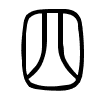The bronze script of character Temple is
The bottom is character Again - 又 (Post 102), means "Hand".
The top is character Of - 之 (Post 370)
Which means "Right here", "From here", "Here is our base".
Some people think that it is character Stop or Foot - 止 (Post 93).
Which implies that Solid (can't be moved), Stable, etc.
The two meanings are close. But it likes more like character Of - 之. The top should be mainstay, either the physical buildings or government power, or laws. It is impossible for people to move it by hands. However, if you think that it is the character Stop, which makes sense too.
The character originally means the buildings of Dynasty (government), when Buddhism was introduced into China, it is said that the buddha was originally settled in this kind buildings, or similar buildings. Gradually its meaning changed to Temple, the meanings of government building or power or laws disappeared because the temples moved out of the government buildings.
The big seal script of the character is
The top is character Stop now, the bottom is hand.
The small seal script of the character is
The top is character Of. As I mentioned above, the meanings of the two characters are close, and they look like similar, so people wrote back or forth, but the basic meaning is not changed.
The bottom is character Chinese Inch - 寸 (Post 98), in ancient time, 寸 and 手 - hand, are exchangeable.
The clerical script of the character is
The top two curve become one straight horizontal line, making the top as character Soil - 土 (Post 223). The bottom is character Chinese Inch, the curves are changed to straight lines. It is typical for clerical script to make most curves to straight lines in order to be able to write faster but losing the pictography.
The song typeface of the character is
寺
Same as clerical script.
The pinyin of 寺 is Si4.
Right now, 寺 is most of time specifically for Buddhist temple unless there is explanation otherwise. Most of other temples (if not all) are called 庙 (Post 318). People normally use "寺庙“ (Put the two characters together) to mean all religious temples.






















































